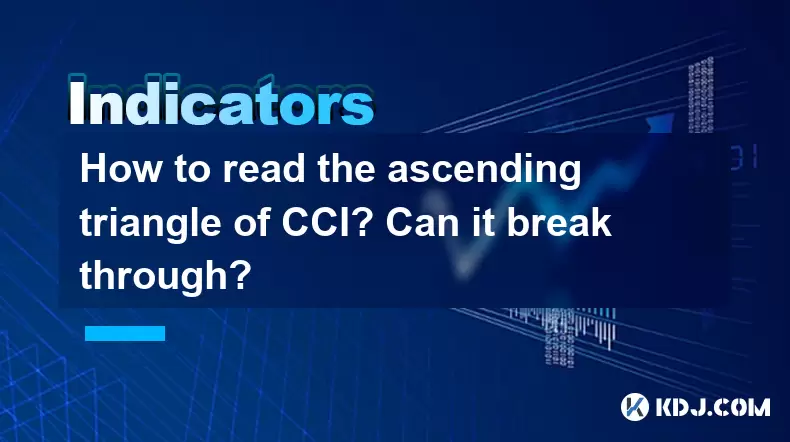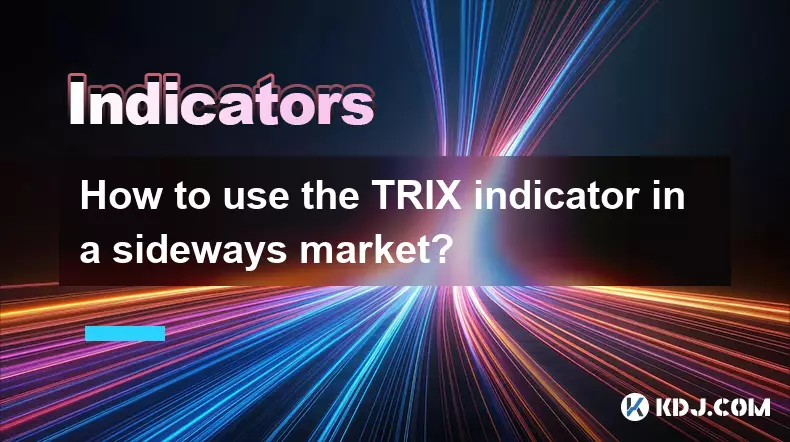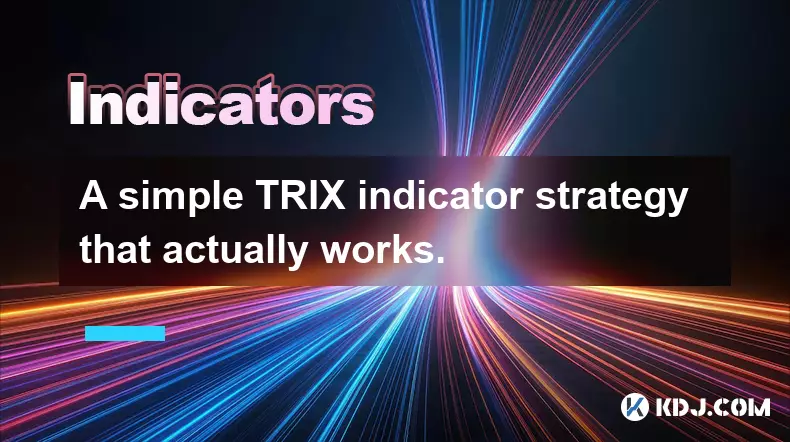-
 bitcoin
bitcoin $105968.894684 USD
4.17% -
 ethereum
ethereum $3639.320047 USD
7.62% -
 tether
tether $1.000339 USD
0.06% -
 xrp
xrp $2.407774 USD
5.96% -
 bnb
bnb $1011.704193 USD
2.28% -
 solana
solana $166.942754 USD
6.37% -
 usd-coin
usd-coin $1.000143 USD
0.03% -
 tron
tron $0.291515 USD
0.25% -
 dogecoin
dogecoin $0.181682 USD
4.06% -
 cardano
cardano $0.585450 USD
4.54% -
 hyperliquid
hyperliquid $42.099968 USD
5.20% -
 chainlink
chainlink $16.160745 USD
5.45% -
 zcash
zcash $645.269648 USD
12.96% -
 bitcoin-cash
bitcoin-cash $507.430338 USD
2.80% -
 stellar
stellar $0.290357 USD
3.69%
How to read the ascending triangle of CCI? Can it break through?
The ascending triangle in CCI signals a potential bullish breakout when it forms higher lows and a flat upper resistance, confirmed by increased volume.
May 23, 2025 at 05:57 am

Understanding the Ascending Triangle Pattern in CCI
The Commodity Channel Index (CCI), developed by Donald Lambert, is a versatile indicator used by traders to identify cyclical trends in commodities and other financial instruments, including cryptocurrencies. One of the patterns traders often look for within the CCI is the ascending triangle. This pattern is crucial as it can signal a potential breakout and continuation of the current trend.
In this article, we will delve into how to read the ascending triangle pattern within the CCI and discuss the likelihood of a breakout occurring.
What is an Ascending Triangle in CCI?
An ascending triangle is a bullish continuation pattern that forms during an uptrend. Within the context of the CCI, this pattern occurs when the indicator forms a series of higher lows while the upper boundary remains relatively flat. The pattern resembles a triangle with a horizontal top and an upward-sloping bottom.
To identify an ascending triangle in CCI:
- Look for a flat upper resistance level where the CCI repeatedly touches but fails to break through.
- Observe a series of higher lows forming the lower boundary of the triangle, indicating increasing bullish momentum.
How to Read the Ascending Triangle in CCI
Reading the ascending triangle within the CCI involves several steps to confirm the pattern and assess its strength:
- Identify the Pattern: Confirm that the CCI is forming higher lows and is repeatedly touching the same upper resistance level.
- Measure the Triangle's Height: Calculate the vertical distance from the highest point on the triangle's upper boundary to the lowest point on the lower boundary. This measurement can be used to estimate the potential breakout target.
- Volume Analysis: Monitor the trading volume as the pattern develops. An increase in volume as the price approaches the upper boundary can signal a stronger likelihood of a breakout.
- Breakout Confirmation: A breakout is confirmed when the CCI decisively breaks above the upper resistance level on increased volume.
Can the Ascending Triangle in CCI Break Through?
The potential for an ascending triangle in CCI to break through depends on several factors:
- Strength of the Trend: A strong underlying uptrend increases the likelihood of a successful breakout.
- Volume Confirmation: A breakout accompanied by a significant increase in volume is more likely to be sustained.
- Previous Breakouts: Analyze the asset's history of breakouts to gauge the reliability of the pattern.
While no pattern guarantees a breakout, the ascending triangle in CCI is considered a reliable bullish signal when all conditions are met.
Trading Strategies Based on the Ascending Triangle in CCI
Traders can use the ascending triangle in CCI to develop effective trading strategies:
- Entry Point: Enter a long position once the CCI breaks above the upper resistance level on high volume.
- Stop Loss: Place a stop loss just below the most recent low within the triangle to manage risk.
- Profit Target: Set a profit target by adding the height of the triangle to the breakout point.
For example, if the height of the triangle is 100 points and the breakout occurs at a CCI value of 200, the profit target would be set at 300.
Practical Steps to Trade an Ascending Triangle in CCI
Here are the detailed steps to trade an ascending triangle pattern identified in the CCI:
- Identify the Pattern: Use charting software to plot the CCI and look for the formation of higher lows and a flat upper resistance level.
- Confirm the Pattern: Ensure that the pattern has at least two touches on the upper boundary and two higher lows on the lower boundary.
- Monitor Volume: Keep an eye on the volume as the price approaches the upper resistance level.
- Set Up Trade: Once the CCI breaks above the upper resistance level on increased volume, enter a long position.
- Place Stop Loss: Set a stop loss just below the most recent low within the triangle to limit potential losses.
- Set Profit Target: Calculate the height of the triangle and add it to the breakout point to determine the profit target.
- Monitor the Trade: Watch the trade closely, adjusting the stop loss to lock in profits as the price moves in your favor.
Frequently Asked Questions
Q: How reliable is the ascending triangle pattern in CCI for cryptocurrencies?A: The reliability of the ascending triangle pattern in CCI for cryptocurrencies can vary based on market conditions and the specific asset being traded. Generally, when all conditions are met, including a strong underlying trend and volume confirmation, the pattern can be a reliable bullish signal.
Q: Can the ascending triangle in CCI also signal a bearish reversal?A: While the ascending triangle is typically a bullish continuation pattern, it can occasionally signal a bearish reversal if the breakout fails and the price moves below the lower boundary of the triangle. Traders should be cautious and monitor for false breakouts.
Q: How long does it typically take for an ascending triangle in CCI to form and break out?A: The duration of an ascending triangle in CCI can vary widely, from a few days to several weeks. The time it takes to form and break out depends on the volatility and trend strength of the underlying asset.
Q: Are there any other indicators that can be used in conjunction with the ascending triangle in CCI?A: Yes, traders often use other indicators like the Relative Strength Index (RSI) or Moving Average Convergence Divergence (MACD) to confirm the signals provided by the ascending triangle in CCI. Combining multiple indicators can increase the reliability of the trading signals.
Disclaimer:info@kdj.com
The information provided is not trading advice. kdj.com does not assume any responsibility for any investments made based on the information provided in this article. Cryptocurrencies are highly volatile and it is highly recommended that you invest with caution after thorough research!
If you believe that the content used on this website infringes your copyright, please contact us immediately (info@kdj.com) and we will delete it promptly.
- Altcoins, BlackRock, and a Bitcoin-Bullish Future: What's the Play?
- 2025-11-10 20:50:01
- Bitcoin Gains and Market Moves: What's Happening?
- 2025-11-10 20:35:01
- Zcash Price Prediction: Will the ZEC Breakout Continue?
- 2025-11-10 18:45:01
- XRP Price, AlphaPepe, and Predictions: What's the Buzz?
- 2025-11-10 18:55:01
- Crypto Explode: News Insights for Savvy Investors
- 2025-11-10 19:10:01
- XRP Price Rockets Amid ETF Buzz, Zcash Mimics Moonshot: A Breakdown
- 2025-11-10 19:10:01
Related knowledge

What's the best way to learn the TRIX indicator?
Nov 10,2025 at 12:39pm
Understanding the Basics of the TRIX Indicator1. The TRIX (Triple Exponential Average) indicator is a momentum oscillator designed to filter out short...

How do professional traders use the TRIX indicator?
Nov 06,2025 at 04:40pm
Understanding the TRIX Indicator in Crypto TradingThe TRIX (Triple Exponential Average) indicator is a momentum oscillator used by professional trader...

Can I use the TRIX indicator on my mobile trading app?
Nov 07,2025 at 07:40pm
The TRIX indicator, a momentum oscillator designed to filter out short-term fluctuations and highlight long-term trends, has become increasingly popul...

How to use the TRIX indicator in a sideways market?
Nov 10,2025 at 03:00pm
Bitcoin’s Role in Decentralized Finance Evolution1. Bitcoin remains the cornerstone of decentralized finance, serving as both a store of value and a b...

How to code a simple TRIX indicator script in Pine Script?
Nov 07,2025 at 06:20am
How to Code a Simple TRIX Indicator in Pine Script The TRIX (Triple Exponential Moving Average) indicator is widely used in cryptocurrency trading to ...

A simple TRIX indicator strategy that actually works.
Nov 08,2025 at 05:39pm
Understanding the TRIX Indicator in Crypto Trading1. The TRIX (Triple Exponential Average) indicator is a momentum oscillator designed to filter out s...

What's the best way to learn the TRIX indicator?
Nov 10,2025 at 12:39pm
Understanding the Basics of the TRIX Indicator1. The TRIX (Triple Exponential Average) indicator is a momentum oscillator designed to filter out short...

How do professional traders use the TRIX indicator?
Nov 06,2025 at 04:40pm
Understanding the TRIX Indicator in Crypto TradingThe TRIX (Triple Exponential Average) indicator is a momentum oscillator used by professional trader...

Can I use the TRIX indicator on my mobile trading app?
Nov 07,2025 at 07:40pm
The TRIX indicator, a momentum oscillator designed to filter out short-term fluctuations and highlight long-term trends, has become increasingly popul...

How to use the TRIX indicator in a sideways market?
Nov 10,2025 at 03:00pm
Bitcoin’s Role in Decentralized Finance Evolution1. Bitcoin remains the cornerstone of decentralized finance, serving as both a store of value and a b...

How to code a simple TRIX indicator script in Pine Script?
Nov 07,2025 at 06:20am
How to Code a Simple TRIX Indicator in Pine Script The TRIX (Triple Exponential Moving Average) indicator is widely used in cryptocurrency trading to ...

A simple TRIX indicator strategy that actually works.
Nov 08,2025 at 05:39pm
Understanding the TRIX Indicator in Crypto Trading1. The TRIX (Triple Exponential Average) indicator is a momentum oscillator designed to filter out s...
See all articles





















![The Graph Price Prediction [GRT Crypto Price News Today] The Graph Price Prediction [GRT Crypto Price News Today]](/uploads/2025/11/07/cryptocurrencies-news/videos/690d4df44fe69_image_500_375.webp)




















































